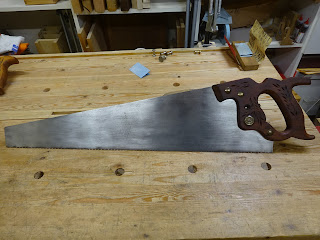This is part 2 of the posts about a Disston D-23 crosscut panel saw that I found at a garage sale a few years ago.
The handle was scraped (including the crud inside the carved leaves) and sanded and given a few coats of BLO/turpentine. It looks pretty good now, and I'm guessing the wood is apple.
 |
Handle removed and partially scraped
|
 |
The handle darkened quite a bit with the oil
|
The brass saw nuts and medallion were cleaned up with a wire wheel in the drill. The saw plate needed a lot of work. Remarkably is was almost perfectly straight. But it was pretty grungy. After scraping off the heavy gunk with a razor blade, sandpaper was wrapped around a flat block and used to remove a lot of the black oxides. On the left side I was careful not to affect the etch.
 |
Right side ready for sanding - this is a very messy task
|
 |
Sanding in progress - avoiding the etch
(etch area is darker more due to the lights than lack of sanding)
|
 |
| Then into a citric acid bath and here ready for more sanding with 150 through 400 grit |
 |
Left side
|
 |
Right side
|
 |
Etch still visible
|
OK, on to the sharpening. This saw was used a lot, though probably not for many years. It was not originally this way, but the tooth line was slightly breasted and I aimed to flatten it. Also, the teeth were not evenly spaced. This was an 8 ppi saw and I'm trying to get it back to proper spacing. The last four inches near the handle were particularly rough and I ended up settling for what I could get there.
 |
Filing straight across (no fleam) to regain proper shape
|
 |
Using a spacing template - note the template peaks are at the left side of the flats here.
I put pressure laterally left to "move" those teeth left. |
 |
A little further down, the template peaks are at the right end of the flats.
I used lateral pressure right to move those teeth right. |
 |
But at the rear of the saw, the tooth peaks were nowhere near the template peaks.
|
Just getting these rear-most teeth closer to proper position led to a large drop in tooth level, relative to the rest of the teeth.
 |
Held against a straightedge, you can see that the
last few inches of teeth drop away |
It took two rounds of jointing and filing just to get those last teeth in the ballpark, and even so they're not near perfect. Maybe with a lot of use and repeated sharpening I can get it more even.
When I got that as even as I could, I sharpened the saw with 20° fleam and 14° of rake. I did this very carefully as I have a tendency to end up with uneven gullets (cows and calves). But I went slowly, going from both sides and sneaking up on the disappearance of the tooth-top flats.
And here she is. The saw is still missing a saw nut, but I put the missing one in the middle - it had been at the bottom - and the handle is rock solid.
 |
Glamour shot
|
I made a test cut and it cuts beautifully. I can't imaging this saw will supplant my 100 year old D-115, but I'm looking forward to using it.













